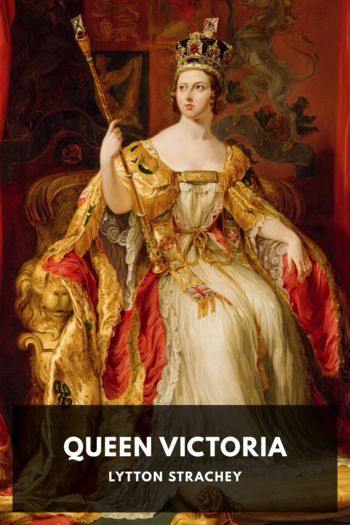Queen Victoria Lytton Strachey (a book to read .txt) 📖

- Author: Lytton Strachey
Book online «Queen Victoria Lytton Strachey (a book to read .txt) 📖». Author Lytton Strachey
By Lytton Strachey.
This ebook is the product of many hours of hard work by volunteers for Standard Ebooks, and builds on the hard work of other literature lovers made possible by the public domain.
This particular ebook is based on a transcription produced for Project Gutenberg and on digital scans available at the Internet Archive.
The writing and artwork within are believed to be in the U.S. public domain, and Standard Ebooks releases this ebook edition under the terms in the CC0 1.0 Universal Public Domain Dedication. For full license information, see the Uncopyright at the end of this ebook.
Standard Ebooks is a volunteer-driven project that produces ebook editions of public domain literature using modern typography, technology, and editorial standards, and distributes them free of cost. You can download this and other ebooks carefully produced for true book lovers at standardebooks.org.
Authority for every important statement of fact in the following pages will be found in the footnotes.
The author is indebted to the Trustees of the British Museum for their permission to make use of certain unpublished passages in the manuscript of the Greville Memoirs.
Queen Victoria I Antecedents IOn November 6, 1817, died the Princess Charlotte, only child of the Prince Regent, and heir to the crown of England. Her short life had hardly been a happy one. By nature impulsive, capricious, and vehement, she had always longed for liberty; and she had never possessed it. She had been brought up among violent family quarrels, had been early separated from her disreputable and eccentric mother, and handed over to the care of her disreputable and selfish father. When she was seventeen, he decided to marry her off to the Prince of Orange; she, at first, acquiesced; but, suddenly falling in love with Prince Augustus of Prussia, she determined to break off the engagement. This was not her first love affair, for she had previously carried on a clandestine correspondence with a Captain Hess. Prince Augustus was already married, morganatically, but she did not know it, and he did not tell her. While she was spinning out the negotiations with the Prince of Orange, the allied sovereign—it was June, 1814—arrived in London to celebrate their victory. Among them, in the suite of the Emperor of Russia, was the young and handsome Prince Leopold of Saxe-Coburg. He made several attempts to attract the notice of the Princess, but she, with her heart elsewhere, paid very little attention. Next month the Prince Regent, discovering that his daughter was having secret meetings with Prince Augustus, suddenly appeared upon the scene and, after dismissing her household, sentenced her to a strict seclusion in Windsor Park. “God Almighty grant me patience!” she exclaimed, falling on her knees in an agony of agitation: then she jumped up, ran down the backstairs and out into the street, hailed a passing cab, and drove to her mother’s house in Bayswater. She was discovered, pursued, and at length, yielding to the persuasions of her uncles, the Dukes of York and Sussex, of Brougham, and of the Bishop of Salisbury, she returned to Carlton House at two o’clock in the morning. She was immured at Windsor, but no more was heard of the Prince of Orange. Prince Augustus, too, disappeared. The way was at last open to Prince Leopold of Saxe-Coburg.
This Prince was clever enough to get round the Regent, to impress the Ministers, and to make friends with another of the Princess’s uncles, the Duke of Kent. Through the Duke he was able to communicate privately with the Princess, who now declared that he was necessary to her happiness. When, after Waterloo, he was in Paris, the Duke’s aide-de-camp carried letters backwards and forwards across the Channel. In January 1816 he was invited to England, and in May the marriage took place.1
The character of Prince Leopold contrasted strangely with that of his wife. The younger son of a German princeling, he was at this time twenty-six years of age; he had served with distinction in the war against Napoleon; he had shown considerable diplomatic skill at the Congress of Vienna;2 and he was now to try his hand at the task of taming a tumultuous Princess. Cold and formal in manner, collected in speech, careful in action, he soon dominated the wild, impetuous, generous creature by his side. There was much in her, he found, of which he could not approve. She quizzed, she stamped, she roared with laughter; she had very little of that self-command which is especially required of princes; her manners were abominable. Of the latter he was a good judge, having moved, as he himself explained to his niece many years later, in the best society of Europe, being in fact “what is called in French de la fleur des pois.” There was continual friction, but every scene ended in the same way. Standing before him





Comments (0)